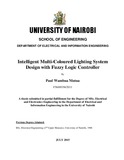| dc.description.abstract | This thesis is about design of an intelligent energy efficient lighting system based on fuzzy
logic controller that uses multi-colour LEDs to produce light of the required luminance level
and appropriate colour in a typical room space. The lighting system incorporates automatic
controlling of a room’s window shade opening, conveniently harvesting daylight. Appropriate
room occupancy sensors were set to dim off the LEDs if there are no people in the room. A
movement sensor was also considered for dimming the LEDs if the persons in the room are
asleep. A colour sensor or decoder was included in the control system to dim off the LEDs if
the colour signal is not initiated. The colour decoder signal determine the LEDs’ output light
colour, and close the window shades if the required room’s light colour is not white. Two
Fuzzy Logic controllers were used in the system; the first one to control opening of the room’s
window shades, and the other to control the LEDs’ output luminance level.
The study was limited to simulation of the design in a MATLAB software environment.
However, a proposal of the appropriate hardware that could be used to actualize the lighting
system was also researched and a labeled block diagram for the same provided.
The appropriate devices were identified, configured and assembled into a complete operating
simulate system using a MATLAB-Simulink applications software. The designed system was
simulated in the computer MATLAB environment, and the results were observed and
monitored using the associated Simulink scopes.
The LEDs were observed (via current pulse width) to dim accordingly in response to level of
illumination in the room; the higher the outdoor light into room, the smaller the luminance from
the LEDs. If outdoor light is very low, the window shade was observed to close. Also observed
was the window shade closing when the LEDs output light colour is not white. The simulated
model was able to calculate accurately the respective primary colour-part ratios, where the
values were used in driving the RGB LEDs for production the required room lighting colour.
The designed multi-coloured LED lighting system model is intelligent in saving lighting
electric energy, and providing room illumination levels and lighting colour requirements | en_US |

